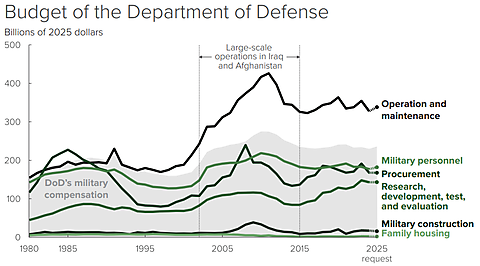Chris Edwards
With today’s massive budget deficits, the Trump administration and Congress should look for savings in every federal department. That includes the massive $859 billion Department of Defense (DOD) and the huge $365 billion Department of Veterans Affairs (VA).
The Congressional Budget Office released charts last week with an overview of spending in the two departments.
This chart breaks down DOD spending into six components in constant dollars. Note the huge operations and maintenance costs of the Iraq and Afghanistan wars, and notice how this part of spending remained elevated even after the wars ended.
And note the sharp decline in spending on procurement and personnel during the 1990s. We always hear that the “military-industrial complex” has unbeatable lobbying power. Members of Congress will go to the mat defending spending on bases and weapons systems in their districts.
Yet in the 1990s, Congress wanted to cut military spending, and it did, sharply. The lesson is that Congress can cut any spending any time it wants. Members do not have to be slaves of parochial interests and campaign contributions. Today, we need them to legislate in the national interest by cutting spending across the federal budget to avert a fiscal disaster.
This chart shows the other financial cost of national defense—the budget of the VA. Here are a few interesting points from the CBO study:
- “After experiencing very little growth from 1980 to 1999, VA’s budget has more than quadrupled in real terms since 1999.”
- “VA’s funding has grown since 2000, though the number of veterans has been declining.”
- “Because of policy changes, veterans who served after 9/11 (known as Gulf War II veterans) are more likely to get benefits, whether they served in combat or not.”
The combined spending of the DOD and VA in 2025 will be $1.2 trillion. That will be 17 percent of total federal spending and 20 percent of spending aside from interest costs.
These two departments are ripe for the types of efficiency reforms that Elon Musk and his DOGE team are promoting. Regarding the DOD, for example, policymakers should close excess foreign military bases and thin the department’s bloated civilian bureaucracy of 795,000 employees.
Congress needs to step up to the reform plate and start assembling lists of programs to cut and eliminate. The CBO describes dozens of possible DOD and VA reforms here, and Cato discusses wide-ranging budget reforms in its recent DOGE report here.
# # #
Note: the components of the first chart add to $848 billion in 2025, which differs a bit from the $859 billion for DOD in CBO’s January Outlook.



